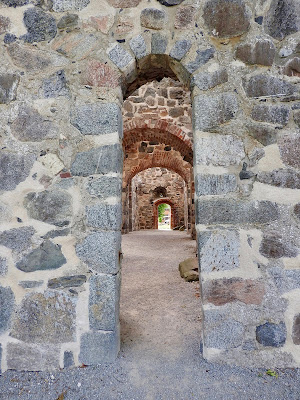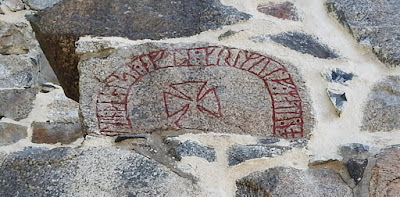目次 / Contents
1) シグトゥーナのルーン石碑 / Runestones in Sigtuna
2) 二人のオーロフ王 / Two King Olofs
3) 聖オーロフ教会遺跡 / St. Olofs Church Ruins
4) 聖オーロフ教会のルーン石碑 / Runestone of St. Olofs Church1) シグトゥーナのルーン石碑 / Runestones in Sigtuna
シグトゥーナ は、ヴァイキング時代 (Viking Age / 793 - 1066) から、
中世時代の1200年頃まで100年以上に渡って栄えました。
シグトゥーナのルーン石碑は、発掘された小さな破片も数え、
町だけで40をはるかに超える数が記録されています。
自治体全体を含めると、この数は170に増えます。
Pale Orange Part : Sigtuna Municipality
Sigtuna is a small town (village) in the north of Stockholm,
with the same name as Sigtuna municipality,
probably because it is the oldest town in Sweden.
Sigtuna had flourished for over 100 years,
from the Viking Age (793 - 1066) to the 1200s of the Middle Ages.
The more than 40 Sigtuna Runestones recorded includes
small fragments unearthed just from the town.
The number rises to 170 when including the whole municipality.
画像は下記より / This from below
★ |
 |
| 散策マップ
シグトゥーナには、ヴァイキング時代に作られたと
思われるルーン石碑が複数あり、町の散策マップにも記されています。
Town Walk Map私と夫Rは、この地図を見つつ、主にルーン石碑の場所を訪ねました。
Sigtuna has Runestones that are believed to have been set up
during the Viking Age and are noted on the town walk map.
While looking at this map, I and my husband R mainly visited the sites of the Runestones. |
教会の敷地 / Church Grounds
 |
案内板
左上が聖マリア教会
左下に聖オーロフ教会遺跡
Guide Board
Upper left is St. Mary's Church.
St .Olofs Church Ruins in the lower left.
|
ルーン石碑を追って、最初に訪れたのは、町の東にある教会の敷地でした。
そこには、今も使用されている聖マリア教会 / St. Mary's Church / Mariakyrkanと
聖オーロフ教会遺跡 / St. Olofs Church Ruins (Sankt Olofs kyrkoruin) があります。
聖オーロフ教会遺跡 / St. Olofs Church Ruins (Sankt Olofs kyrkoruin) があります。
聖マリア教会については下記。
㉗ - D 2019年9月3日 b) ルーン石碑を追って- シグトゥーナ - ストックホルム旅行 /..
このセクションは、聖オロフ教会の遺跡とルーン石碑の写真を載せます。
このセクションは、聖オロフ教会の遺跡とルーン石碑の写真を載せます。
3 : 元ハーブ・ガーデン / Originally Herb Garden
4 : 聖マリア教会 / St. Mary's Church 5 : 聖オーロフ教会遺跡 / St. Olofs Church Ruins |
Runestones in Sigtuna
Following the Runestones, our first visit was to the church grounds to the east of the town.
There are St. Mary's Church / Mariakyrkan and St. Olofs Church Ruins (Sankt Olofs kyrkoruin)
About St. Mary's Church, below.
There are photographs of Saint Olof Church Ruins and the Runestone in this section.
2) 二人のオーロフ王 / Two King Olofs
 |
説明板
残った地域でした。
シグチューナは、980年頃に、スウェーデン王、
エリク6世の息子、
オーロフ王 / オーロフ・シェートコヌング /
Olof Skötkonung / King Olof (? - 1022 / 在位:994頃 - 1022頃)
は、1008年頃、西方教会 (ローマ・カトリック教会) の洗礼を受けました。
これは、スウェーデンで王として、最初の洗礼でした。
けれども、聖オーロフ教会遺跡のオーロフは、
Olaf II Haraldsson / Olof (II) Haraldsson / 995 - 1030 / 在位:1015 – 1028」
に由来し、聖オーロフ教会の守護聖人は、この王でした。
Explanation Board
Sweden was one of the last areas in Nordic countries
to remain pagan (Gods of Norse Mythology).
Sigtuna was founded around 980 by the Swedish King,
Eric the Victorious (Eric VI / c. 956 - 995 / reign : 970 - 995)
as Sweden's first Christian town.
The son of Erik VI, Olof Skötkonung (King Olof / ? -1022 / reign:c.994 - c.1022)
was baptized by the Western Christianity (Roman Catholic Church) around 1008.
This was the first baptism of a king in Sweden.
However, Olof of St. Olofs Church Ruins originated from the Norwegian King of
Olaf II Haraldsson / Olof (II) Haraldsson (995 - 1030 / reign : 1015 - 1028]
and the patron saint of St. Olofs Church was this King.
二人のオーロフ王
スウェーデン王、オーロフ王の娘アストリッド ( Aestrith Olofsdotter /
Astrid Olofsdotter / 1019 - 1035)とオーロフ2世は結婚しました。
この結婚は、ノルウェーとスウェーデンの和平のための政略結婚でした。
1000年代初頭、オーロフ2世はシグチューナを数回旅をしました。
若い頃、彼はヴァイキングの成功者でした。
彼はメーラレン湖、バルト海、デンマークの海岸周辺で略奪しました。
オロフは北欧地域の最初で最も人気のある聖人になりました。
現代の感覚からすると、各地で略奪した略奪王が聖人になるというのは
理解しがたいです。
ですが、違う言い方をすれば、各地を統合したヒーローなのです。
ヒーローには、奇跡を伴うエピソードが生まれ、
聖人になったのだというのが私の理解です。
Two King Olofs
Aestrith Olofsdotter / Astrid Olofsdotter (1019 -1 035) ,
the daughter of King Olof of Sweden, was married to King Olof II.
This marriage was a political marriage for peace between Norway and Sweden.
In the early 1000s, Olof II traveled to Sigtuna several times.
When he was young, he was a successful Viking.
He plundered Lake Mälaren, the Baltic Sea, and the coast of Denmark.
Olof became the first and most popular saint of the Nordic region.
From a modern sense, it is difficult to understand that the plundering king who plundered in various places became a saint.
But to put it another way, it's a hero who integrates all parts.
My understanding is that the hero made miraculous episodes and became a saint.
|
オーロフ2世は、複数のサガに登場します。
King Olof II appears in several saga.
3) 聖オーロフ教会遺跡 / St. Olofs Church Ruins
 |
| 遺跡のこういう景色が好きです。 なんとなく、時の旅を感じ、ファンタジーの世界も感じます。 I like this kind of view of the ruins. Somehow, I feel the journey through time and fantasy worlds. |
 |
| かなり修復の手が入っているのがわかります。 I can see that there is a lot of repair work done.  私は、遺跡や廃墟が好きです。 I like ruins.  |
 |
| 塔の内部 / Inside of Tower |
 |
ケルト十字
あります (ルーン石碑) が、私はこのケルト十字に碑文があるかの
確認はしませんでした。
Celtic Cross
There is a Celtic cross.
Some Celtic crosses have rune inscriptions (runestones),
but I didn't check if this Celtic cross had an inscription.
|
3) 聖オーロフ教会のルーン石碑
Runestone of St. Olofs Church
 |
| 塔の左上にルーン石碑が嵌められています。 A Runestone is attached to the upper left of the tower.  ルーン石碑 385 / Runestone 385 
"....この石は彼の仲間であるグリムルフ: Grimulfr を記念して...
Grimulfrという名前は、他の4つのスウェーデンのルーン文字の碑文にあります。
matunautr、mateという言葉は、旅の途中で自分たちのことを
分かち合った商人を意味します。
トルビョルン / Torbjörnは、また、マリア教会にある、ルーン石碑:U379 、
プレストガタン (Prästgatan : 旧市街のガムラ・スタンにある、古い公道) の
境界U 391(ルーン石碑; U391)、
そして、おそらくサンペルの廃墟にある破損したルーン石碑U394を刻みました。
彼の彫りは、11世紀後半にされ、ぎこちなく、装飾性に欠けています。"
"…. this stone in memory of Grimulv, his mate....
The name Grimulfr is found in four other Swedish runic inscriptions.
The word, matunautr, mate, connotes merchants who
shared their proviant during a journey.
Torbjörn has also carved a rune stone at the Maria church, U379,
the boulder U 391 at Prästgatan (Old public road in Gamla stan : old town) and probably the damaged rune stone,
U394, in the ruin of Saint Per.
His carvings are clumsy and lack ornaments, they are
from the second half of the 11th century."
|
 |
| ストックホルム旅行中にあまり、花らしい花を見かけませんでした。 なので、このダリアに目が止まりました。 I didn't see many flowers during our Stockholm trip. So I caught my eyes on this dahlia. |











0 件のコメント:
コメントを投稿